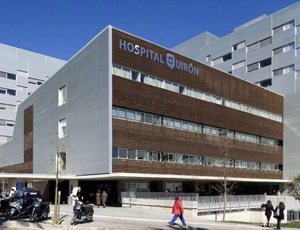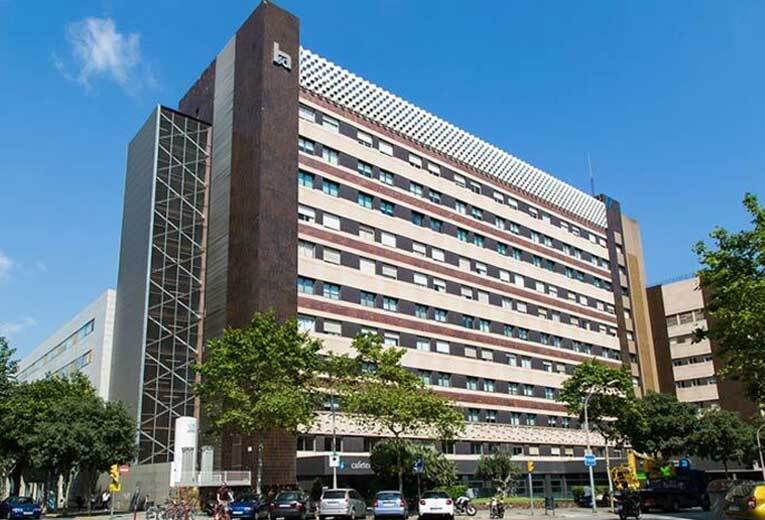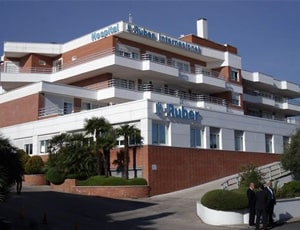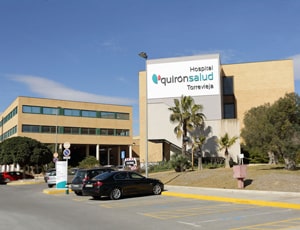The average cost of Breast Cancer Treatment in Barcelona approximately ranges between USD 10540 to USD 12460
Treatment cost

Apart from in-detail treatment procedures available, Hospital Quirnsalud Barcelona located in Barcelona, Spain has a wide variety of facilities available for International Patients. Some of the facilities which are provided by them are Accommodation, Airport Transfer, Choice of Meals, Interpreter, SIM, TV inside room. Also listed below are some of the most prominent infrastructural details:


The cost for Breast Cancer Treatment ranges from USD 10540 - 12460 in Sagrat Cor University Hospital
The Hospital is an amalgamation of a group of buildings located in the Eixample Left of Barcelona, ??between Paris, Viladomat, and London streets. It has a capacity of 350 adjustable beds and first-class hotel-like services inpatient rooms. Currently, it has a workforce of about 1100 Healthcare Professionals.
In order to treat patients with intensive care, the Hospital has 10 beds in its ICU for critically ill patients.
The Hospital has launched a few more things to improve customers’ services- 4 new Operating Rooms and a New Diagnostic Imaging Service.
Other Services
Types of Room
Double Rooms, Double Rooms for Individual Use, and Single Rooms; equipped with an easy-to-use electrical movement control system and a nursing call/warning system, located at the head of the bed, a sofa-bed for the companion, and a bathroom with a shower. They are also equipped with television and telephone.
A cafeteria/Restaurant is also available for the patients or visitors.
SPECIALITIES
FACILITIES & AMENITIES

The Hospital has a wide architectural structure that consists of-

Quironsalud Torrevieja Hospital located in Torrevieja (Alicante), Spain is accredited by ISO. Also listed below are some of the most prominent infrastructural details:
Breast cancer is a type of cancer that originates in the cells of the breast. While it can occur in men as well, it is far more prevalent in women.
Following skin cancer, breast cancer stands as the second most frequently diagnosed cancer among women in the United States. However, it's crucial to recognize that breast cancer is not exclusive to women, as everyone is born with some breast tissue, making it a condition that can affect individuals of any gender.
Improved breast cancer screening techniques enable healthcare providers to detect the presence of breast cancer at an earlier stage. Early cancer detection greatly increases the chances of effective therapy and recovery.
The exact reason that causes breast cancer is unclear, even though every eighth woman suffers from it. However, several factors have been associated with the development of breast cancer. Some of the breast cancer risk factors include:
The risk of breast cancer naturally increases as women age. The risk is also higher in women who have a family history of breast or ovarian cancer, possess BRCA1 and BRCA2 genes, or have had their periods before the age of 12.
The main types of breast cancer are based on where the cancer begins, whether it's in the ducts or lobules of the breast, and whether it has spread beyond its original location. The two broad categories are in situ (confined to the site of origin) and invasive (has spread beyond the original location). Here are some common types:
Most commonly, as a part of treatment for breast cancer, surgery is conducted to remove the cancerous lump or growth from the breasts. Depending on the extent of the cancer and its stage, surgery may be accompanied by another form of treatment as well, which is conducted either before or after the surgery.
The doctor decides upon a breast cancer treatment plan that is most suitable for the patient. The decision may depend upon the extent of spread, the overall health of the patient, the stage, and the type of breast cancer (inflammatory, cancer during pregnancy, lobular carcinoma, ductal carcinoma, and invasive breast cancer).
The team that conducts breast cancer treatment includes a surgeon, a medical oncologist, and a radiation oncologist. The different breast cancer treatment options are divided into two types:
Local Treatment: This type of treatment is localized, that is, it is only used to treat one specific location or primary site affected by cancer. It does not have any impact on the rest of the body.
The following are the two types of local treatment:
The radiation can either be delivered externally or by placing a small radioactive pallet in the affected area internally. The latter form of radiation therapy is known as brachytherapy.
II. Systemic Treatment: This type of treatment involves the use of drugs that can be administered either orally or intravenously. The choice of drugs depends on the type of systemic treatment opted for, which, in turn, is dependent upon the extent and the type of cancer.
The recovery journey following breast cancer treatment, though generally less painful and traumatic than some other critical cancers, brings about certain adjustments for patients. These changes encompass various aspects of their physical and emotional well-being:
Options like cosmetic surgery provide avenues for individuals to regain a sense of normalcy.The unique challenges that breast cancer survivors face underscore the importance of comprehensive support, encompassing physical, emotional, and psychological aspects. While the journey may have its complexities, addressing these changes with a tailored and holistic approach contributes to individuals' overall well-being and resilience in their recovery.
Ask your healthcare adviser for the best multiple options and choose the one that meets your expectations
$10540 is the starting cost of Breast Cancer Treatment Surgery in Barcelona. Breast Cancer Treatment in Barcelona is conducted across several JCI, OHSAS certified hospitals.
Different hospitals have different pricing policy when it comes to the cost of Breast Cancer Treatment in Barcelona. Some of the best hospitals for Breast Cancer Treatment offer a comprehensive package that covers the end-to-end expenses related to investigations and treatment of the patient. The comprehensive Breast Cancer Treatment package cost includes the cost of investigations, surgery, medicines and consumables. There are many things that may increase the cost of Breast Cancer Treatment in Barcelona, including prolonged hospital stay and complications after the procedure.
Breast Cancer Treatment in Barcelona is offered by multiple hospitals across the country. Some of the best hospitals for Breast Cancer Treatment in Barcelonainclude the following:
While the speed of recovery may vary from patient to patient, they are still required to stay for about 26 days after discharge. This is important to ensure that the surgery was successful. During this time, control and follow-up tests take place to check for medical fitness.
Barcelona is one of the most popular cities for Breast Cancer Treatment in the world. The country offers the best cost of Breast Cancer Treatment, best doctors, and advanced hospital infrastructure. However, there are other cities as mentioned below that are popular for Breast Cancer Treatment as well:
Apart from the Breast Cancer Treatment cost, the patient may have to pay for additional daily expenses such as for guest house after discharge and meals. These are the charges for daily meals and accommodation outside the hospital. The per day cost in this case may range from 45 USD.
After the Breast Cancer Treatment surgery takes place, the average duration of stay at the hospital is about 4 Days. The patient is subjected to several biochemistry and radiological scans to see that everything is okay and the recovery is on track. After making sure that patient is clinically stable, discharge is planned.
There are about 2 Hospitals Breast Cancer Treatment hospitals in Barcelona that are best known for their services. These hospitals have proper infrastructure for the treatment of patients who require Breast Cancer Treatment. These hospitals comply with all the rules and regulations as dictated by the regulatory bodies and medical association in Barcelona
Some of the most sought after doctors for Breast Cancer Treatment in Barcelona are:
Some of the top hospitals in Barcelona for Breast Cancer Treatment and their associated prices:
| Hospital | Minimum Cost | Maximum Cost |
|---|---|---|
| Sagrat Cor University Hospital, Barcelona | USD 10540 | USD 12460 |
Barcelona, a city in Spain has now become a popular destination for medical travelers owing to its reliable and high-quality healthcare system. The city has around 58 hospitals, out of which 12 are public and 46 are private. These hospitals provide outstanding non-elective and elective treatments. They have some of the best doctors in the country and are equipped with the latest medical technology. Some of the hospitals in Barcelona have also earned recognition from international organizations such as JCI. It is easy for foreign patients to avail treatments from Barcelona’s hospitals as most of these facilities have translation services. The medical staff is also fluent in languages such as English. The most common healthcare services obtained by international travelers in Barcelona are dental implants, cosmetic and plastic surgery, teeth whitening, in-vitro fertilization, artificial insemination, and weight loss surgery.
Due to the excellent healthcare delivered, several hospitals in Barcelona have received JCI accreditation. The hospitals provide a range of healthcare services in various disciplines and are staffed with expert doctors and physicians. Some of the top hospitals in Barcelona are:
Barcelona has a pool of exceptional doctors with substantial experience in their field. Some of the top doctors in Barcelona are:
You can reach Barcelona by any type of transportation whether plane, train or car. If you wish to travel to Barcelona for your medical treatment then we can provide assistance in planning your medical travel so that you get the best care.